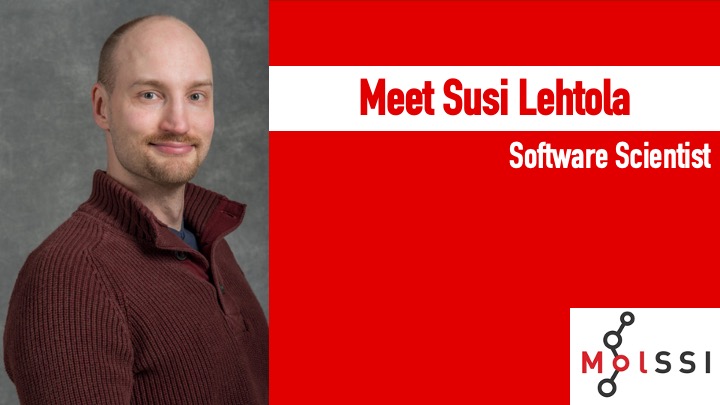
MolSSI Software Scientist: Dr. Susi Lehtola
Dr. Susi Lehtola earned his PhD in theoretical physics in 2013 from the University of Helsinki. After graduating, he joined Prof. Hannes Jónsson at Aalto University for a 16-month postdoc, and then worked with Prof. Martin Head-Gordon at Lawrence Berkeley National Laboratory for another three years. Susi was awarded a three-year Academy of Finland postdoctoral fellowship in the fall of 2017, and has joined MolSSI as of October 2020.
Susi is passionate about free software, as it makes computational science more accessible. Susi has used Linux as his main operating system since 2002. Susi has also been a Fedora Linux developer since 2008, and has packaged a number of molecular sciences software over the years.
At the MSc studies phase, Susi found out he was interested in two topics in particular: quantum mechanics and scientific computing, and so he was recruited to model inelastic X-ray spectra of liquid alcohols for the experimental X-ray physics group of Prof. Keijo Hämäläinen. The approach was to model the atomic structure of the alcohols with molecular dynamics, and to calculate model spectra with single-point density functional calculations. However, Susi realized as a PhD student that he could combine his two main interests – scientific computing and quantum mechanics – by developing a more user-friendly quantum chemistry code to run the X-ray spectrum calculations, giving rise to the ERKALE free software program. ERKALE was made possible by two free software libraries: Eduard Valeev’s libint for two-electron integrals and Miguel Marques’s libxc for exchange-correlation functionals for density functional theory. Since ERKALE was an early adopter of libxc, Susi later ended up as a main developer of libxc. ERKALE was also pivotal for the postdoc with Prof. Jónsson, which focused on new computational approaches for the Perdew-Zunger self-interaction correction employing complex-valued orbitals, which also led to new tools for Pipek-Mezey orbital localization.
At Berkeley, Susi worked on wave function approaches for electronic structure theory. His main achievement was to develop efficient implementations of subtensor truncations of high-level coupled cluster theory like the coupled clusters with single through hextuple excitations (CCSDTQ56) model via the perfect pairing hierarchy. For instance, Susi’s new dense tensor implementation of the perfect quadruples model was found to be 10,000 times faster than the earlier implementation based on sparse tensors, which already exhibited the correct asymptotic scaling.
Upon his return to Helsinki, Susi became interested in fully numerical methods for electronic structure theory. To be able to calculate interatomic potentials at extremely small internuclear distances R << 1 Å which are challenging with atomic-orbital methods, Susi wrote a new program suite for finite element calculations of atoms and diatomic molecules called HelFEM. However, Susi also ended up developing an approach that solves the problems in atomic-orbital calculations with small internuclear distances, which also facilitate the study of weakly bound electrons. Susi also completed basic studies in university pedagogy at the University of Helsinki.
